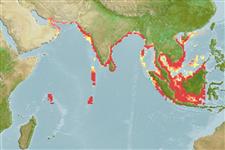Common names from other countries
Environment: milieu / climate zone / depth range / distribution range
экология
морской; солоноватоводный; амфидромный (Ref. 51243). Tropical; 29°N - 8°S, 55°E - 118°E (Ref. 188)
Indo-West Pacific: in tropical waters, from the Gulf of Oman to at least Madras, perhaps to the north and along the coasts of Myanmar, certainly at Penang, to the Java Sea, and Gulf of Thailand.
Size / Вес / Возраст
Maturity: Lm ? range ? - ? cm
Max length : 23.0 cm TL самец/пол неопределен; (Ref. 122100); наибольший вес (опубликованные данные): 87.00 g (Ref. 122100)
Краткое описание
определительные ключи | морфология | морфометрия
колючие лучи спинного плавника (общее число) : 0; колючие лучи анального плавника: 0; членистые (мягкие) лучи анального плавника: 51 - 63. Belly convex in front, with 29 to 35 scutes. Mouth pointing obliquely upward; lower gill rakers 22 to 28, increasing with size of fish. Pectoral fin usually about equal to head length or greater; dorsal fin small, well behind midpoint of body; anal fin long, its origin well before dorsal fin origin.
Found close to shore and also entering estuaries (e.g. Aluhaluh on Barito River in Kalimantan, Indonesia). Ascends rivers into the tidal zone (Ref. 12693). Feeds on mysids, Pseudodiaptomus and copepod eggs, also prawns and other small crustaceans, bivalve eggs and larvae, amphipods and small fishes. Spawns in late February or early March to July or August (around Karwar, India). Used as fish meal or fertilizer (Ref. 4832).
Life cycle and mating behavior
Maturities | размножение | Spawnings | Egg(s) | Fecundities | личинки
Whitehead, P.J.P., 1985. FAO Species Catalogue. Vol. 7. Clupeoid fishes of the world (suborder Clupeoidei). An annotated and illustrated catalogue of the herrings, sardines, pilchards, sprats, shads, anchovies and wolf-herrings. FAO Fish. Synop. 125(7/1):1-303. Rome: FAO. (Ref. 188)
Статус Красного Списка МСОП (Ref. 130435)
CITES (Ref. 128078)
Not Evaluated
Угроза для людей
Harmless
Использование человеком
рыболовство: не имеет хозяйственного значения
дополнительная информация
инструменты
Специальные отчеты
Скачать в формате XML
ресурсы в Интернет
Estimates based on models
Preferred temperature (Ref.
115969): 26.8 - 29.3, mean 28.6 (based on 676 cells).
Phylogenetic diversity index (Ref.
82804): PD
50 = 0.5156 [Uniqueness, from 0.5 = low to 2.0 = high].
Bayesian length-weight: a=0.00724 (0.00474 - 0.01106), b=3.04 (2.92 - 3.16), in cm Total Length, based on LWR estimates for this species & (Sub)family-body (Ref.
93245).
Trophic level (Ref.
69278): 3.4 ±0.46 se; based on food items.
устойчивость к внешним воздействиям (Ref.
120179): высокий, минимальное время удвоения популяции до 15 месяцев (Preliminary K or Fecundity.).
Fishing Vulnerability (Ref.
59153): Low vulnerability (13 of 100).
